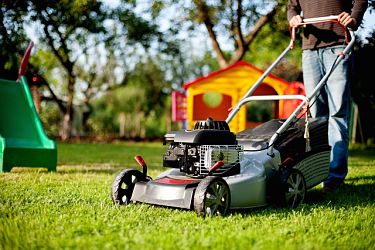 Who wants to throw away money while mowing the lawn? If you don’t prepare your mower for spring with a tune-up, it will likely cost more money later. Tune-ups help your mower last longer, use less fuel, and require fewer repairs. This article outlines key steps in the process of how to tune up a lawn mower.
Who wants to throw away money while mowing the lawn? If you don’t prepare your mower for spring with a tune-up, it will likely cost more money later. Tune-ups help your mower last longer, use less fuel, and require fewer repairs. This article outlines key steps in the process of how to tune up a lawn mower.
Now this is a lesson on tuning up gas powered lawn mowers. Definitely do not apply these with electric lawn mowers.
Basic supplies to obtain include a new air filter, spark plug, and engine oil for your particular mower. (You’ll also require a few basic tools.) It’s practical to take the old air filter and spark plug to the store with you. That way you come home with the right supplies.
Table of Contents [show]
Replace The Air Filter
For the air filter, look on the side of the mower’s engine for a panel likely held by a couple of screws. When you take out the screws and remove the filter, it may be a paper style with rubber surrounding it. If grass and dirt exist in the cavity, you’ll want to brush that out before installing the new air filter.
Replace your air filter at least once per year. Spring offers an easy time to remember to do so. This ensures that clean air enters the engine, and enhances performance compared to a dirty air filter.
You can put the new air filter back into the mower immediately. Just insert it into the cavity the old one had used, and tighten the screws back as before.
Install a new Spark Plug
After removing and replacing the air filter, you can proceed to take out the old spark plug. Different lawn mower models use different places for the spark plug, but you’ll easily locate it when you look for a rubber cable capped on the end of a white tube. You should also spot something similar to a nut where it connects with the mower’s engine. The white part is the spark plug.
Use a bit of pressure to pop the cable off the spark plug. Then you’ll use your socket wrench to unscrew the spark plug from the engine. Don’t replace it immediately, because some later maintenance steps are best performed without the spark plug in place.
Draining Used Oil
Next comes draining the used oil. Two options exist for this step. One involves removing the lid that says “oil”, and tipping the mower on its side to drain the oil into a container. In this case, leave the mower on its side to continue draining all the oil.
However, many mowers include a drain plug, and you could let all the oil drain from this area instead of tipping it over. This will vary with preference and what kind of lawn mower you own.
Removing and Sharpening the Blade
The next step involves removing the blade, because it’s essential to sharpen it at least once per season. This helps the mower run more smoothly, and even contributes to healthier grass because of the more effective cutting.
Make sure the spark plug is out before you even try to remove the blade. You can use a socket wrench to remove the nut on the blade; the size of socket wrench will vary depending on your specific mower.
Actually sharpening the blade requires a few more items. Some examples of materials to use include a flat file, angle grinder, bench grinder, or even 150 grit sandpaper.
Most mower blades don’t require much effort to sharpen, and they don’t have to be extremely sharp to do an effective job cutting grass. A commonly used description is “butter knife sharp.”
If the blade is significantly bent, or has large bings that aren’t easily repaired, you could opt to purchase a new blade. It’s generally less expensive to do that, as opposed to paying someone to repair the used blade.
While the blade is off, take the opportunity to scrape off any layers of grass, dirt, or other material that could make the blade unbalanced in any way. If the blade isn’t balanced properly, the mower will vibrate. The vibration causes wear on the engine.
Take the same precaution when looking underneath the mower deck. You’ll want to scrape off any excessive buildup of grass, dirt, etc.
Reinstall the Blade
After you’ve finished sharpening the blade and removing debris, you’re ready to reinstall the blade. The nut should be very tight. You’ll need a large wrench to perform this task. If you use a torque wrench, follow the instructions carefully regarding its use.
Install New Spark Plug
Next, you’re ready to install the new spark plug, which you do by first threading it by hand until it will thread no further. After that, use a wrench and socket to tighten it an additional ⅛ or ¼ turn.
Refill with Fresh Oil
Refilling with fresh oil comes next. Be certain that you’re filling the oil reservoir and not the gas tank. Try pouring about ¾ of the bottle of oil in, and then wait for it to drain down into the tank. That way you’ll get an accurate measurement on the oil dipstick, and know how much more is needed to fill it adequately.
You can put the used oil into a bottle for recycling. Most auto parts stores accept used oil, at no charge.
Power Wash The Lawn Mower
This is more of a personal preference, but we like to do a quick power wash of the lawn mower before the new season. Sometimes, stuff gets stuck on the mower when sitting in storage and this is just one nice way of adding a little shine to the mower. Definitely put your power washer on the lower settings as anything too powerful could hurt the mower. Again, it’s just a quick little wash.
Miscellaneous Steps
A few other steps include wiping down the outside of your mower with a cloth, assuming you want it to look shiny and new. This also allows the opportunity to check for loose bolts on the wheels, in addition to the handle assembly. Tightening these, as needed, can prevent problems later on.
You can also do a thorough inspection for other problems. Perhaps the throttle cable needs to be adjusted to a proper level of tightness. You’ll have to consult your owner’s manual for instructions on doing this, as this varies widely from one model to another.
Conclusion
If you don’t feel comfortable performing the tune-up yourself, you’ll want to hire a professional. Like any other mechanical device, a lawn mower requires regular maintenance. By taking care of these tasks, you’re protecting your investment. Hopefully it will provide you with many seasons of maintaining a lovely lawn.
Also feel free to check out our other reviews of string trimmer weed wackers. It’s obviously getting to that season again and more tools is always better than less.





